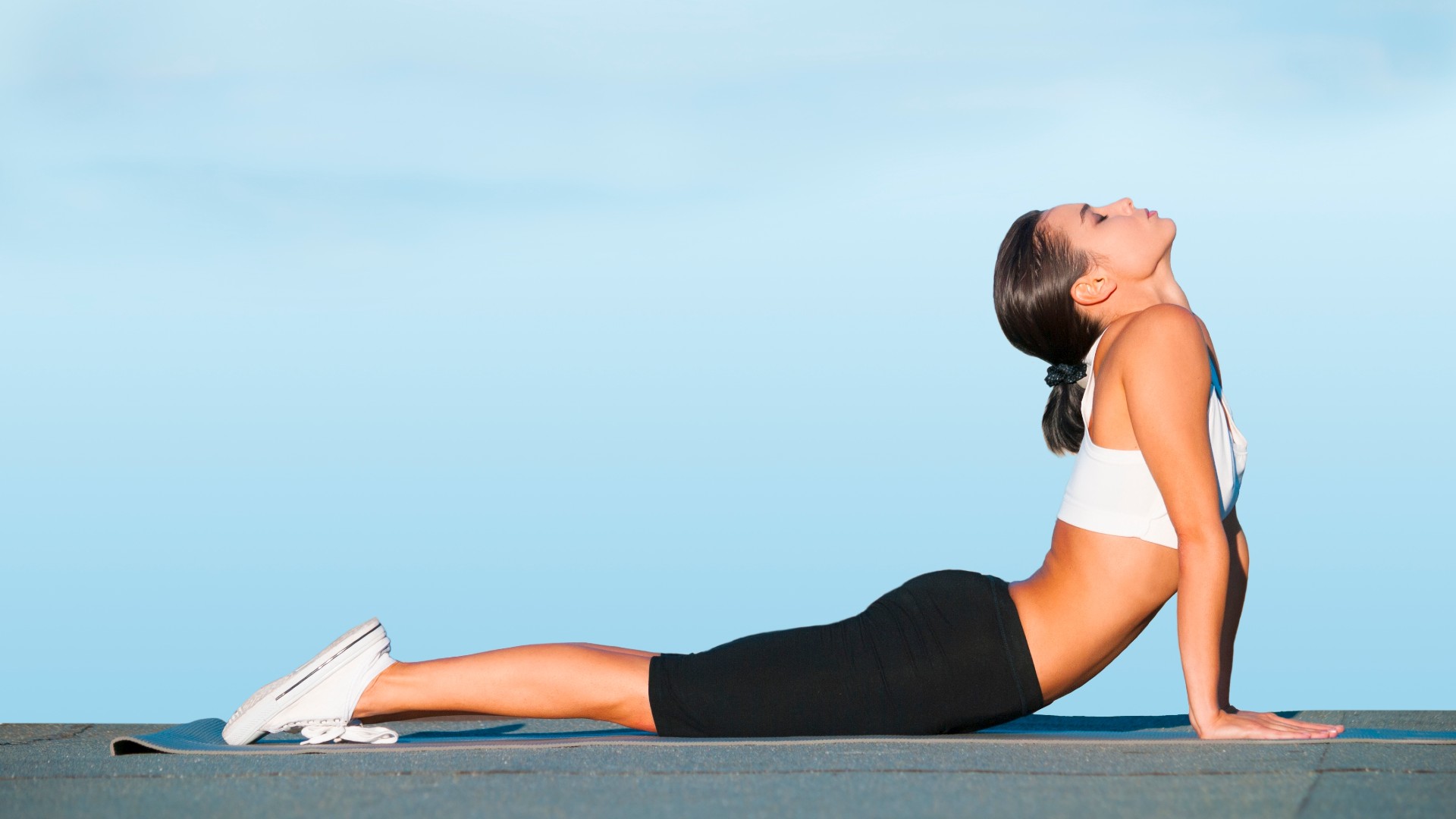
Yoga has many benefits, but still, you might be asking yourself — does yoga build muscle? To answer the question properly, you must understand how to build muscle and adapt your yoga practice to suit your muscle-sculpting goals better.
Firstly, hypertrophy (a fancy name for growing muscle) and building strength are two processes. Both are equally important for your physical health but with different results. Unsurprisingly, there are no free weights or gym machines during a yoga class, so can you really build muscle from a yoga practice?
In the absence of heavy weights like the best adjustable dumbbells, kettlebells, or barbells, yoga is unlikely to develop your top-end strength. Still, you can get stronger, and there are ways to build muscle, although we need to get technical first to understand how both work. Below, we answer whether yoga builds muscle, the differences between hypertrophy and strength training and why it all matters.
Hypertrophy v strength training vs yoga
The hypertrophy versus strength training conversation lays the foundations for building strength and muscle, so whether you’re a weightlifting beginner or a keen yogi, both are worth knowing about. And of all the things I wish I had known before lifting heavy weights, this one didn’t come early enough.
Strength training develops maximal strength and power output — how strong your muscles are. Think about powerlifters during competitions, for example, who work at a much heavier weight close to (or at) a one-rep max — the most you can lift for one repetition. This form of weightlifting helps your brain become more efficient at recruiting muscles and improves your neuropathways, making you stronger and powerful, but not necessarily sculpting muscles. As mentioned, yoga is unlikely to develop maximal strength.
Hypertrophy training increases the size of your muscle fibers and requires a different set of training principles. You’ll lift lighter (at a percentage of your one rep max) and increase the overall volume of your training instead, using a technique called progressive load.
If you follow a hypertrophy program, you’ll adapt the plan over time to overload your muscles, stimulating them to adapt and grow. Progressive overload could mean increasing weight, training frequency, load, reps, exercises, or a combination. We cover the ins and outs of hypertrophy vs strength training, but the progressive overload principle is crucial when considering if and how yoga builds muscle.
Get instant access to breaking news, the hottest reviews, great deals and helpful tips.
Does yoga build muscle?

The benefits of yoga are well documented — better flexibility, mobility and range of motion, strengthened muscles and joints, improved mind-body-breath connection, stability, balance and coordination, and more robust emotional and mental health, to name a few.
It’s worth mentioning, for many people, that yoga is about much more than building muscle, and the practice is rooted in spirituality and lifestyle rather than a workout. That’s why yoga uses asana (poses) and pranayama (breath).
Now that we’ve laid the foundation of what building muscle involves, we’re on to the million-dollar question — will yoga build muscle? It’s not simple, but you can do it, as long as your muscles can consistently meet with challenges and you can tap into overload techniques. Without weights, sets, or reps, sufficient progressive overload is harder to achieve. Alongside increasing the resistance on your muscles, you also need frequency and consistency as your practice develops.
Yoga provides a great mix of isometric and isotonic contractions, creating tension in the muscles without them lengthening or shortening (isometric, like a plank hold) and with movement (isotonic, like moving from upward dog to downward dog), along with pushing exercises, balances and inversions. Yogis can be a pretty sculpted bunch, especially in the arms, shoulders, chest, core and legs.
How to build muscle using yoga
In the absence of weights and using just your body weight (similar to the calisthenics method, but not quite the same thing), the overload principle could guide your practice. Here’s how.

Use time under tension
The time under tension technique means placing muscles under tension for longer, like spending more time in isometric holds, including a plank, lunge, balancing pose, or inversion. You could also move slower during chaturanga and adopt a hatha-based practice, which often involves holding for poses for several breaths. Think about moving with a full range of motion and achieving the full postures to maximize your time spent on the mat.
Progress the exercises
Think about the mechanical disadvantage of making bodyweight exercises harder to perform, for example, a one-armed push-up or one-legged chaturanga. Again, consider holding inversions like handstands for longer or adapting balances for progression. Your yoga teacher will often provide modifications to scale an exercise up and down accordingly, and many studios will advertise advanced or beginner classes to help you pick the class that best suits your ability.
Without sounding cliche, yoga is a journey-driven practice that is endlessly scaleable. In other words, you'll never reach an endpoint.
Increase frequency and consistency
Increase the frequency of your practice or ensure consistency to achieve overload — two fundamental ways to breed results. You could also opt for a lengthier practice, advancing from 30 minutes to 60 minutes or 60 to 90 minutes. If you choose this route, always schedule enough time to rest and recover, especially if you have a vigorous practice style or are new to yoga.
Practice a faster-paced yoga style
A faster dynamic practice could help you build muscle, as classes like vinyasa, rocket, Ashtanga, or Forrest are more demanding on your body than slower-paced classes like yin.
These classes move quickly, are considered harder and involve challenging inversions and balances. You might spend longer in postures or get less rest than with other class styles, and the faster pace can often feel like more of a workout, especially for beginners.
Consider body composition
You might have sculpted lean muscle mass, but can you see it? There are several reasons why you can’t see your abs yet despite working out, but body composition is a big one. A lean and rippling physique is the result of low body fat percentage and muscle mass gain. You might notice results more quickly if you already have a low body fat percentage, but fat loss is the best way to hone your physique if you’re already building muscle.
You can learn how to calculate your body fat percentage and why it matters, but remember to avoid crash diets and prioritize a balanced diet with plenty of sleep and activity throughout your day rather than getting married to numbers. And remember that muscle gains happen over months and years, not days.
Verdict

If you’re new to yoga, you might notice that you grow muscle and get stronger fairly quickly over the first few months, but this progress can plateau as your body adapts.
Begin to play around with the variables above to improve the chances of building muscle as your yoga practice develops, and try various class styles to see which matches the intensity you need. In the meantime, here’s what happened when I did 60 minutes of hot yoga for 6 months and the outcomes for our writer after practicing yin yoga every day for a week.
More from Tom's Guide
- Learn more about muscle fiber types by reading about high reps vs heavy weights
- 5 best ways to build muscle without lifting heavier weights
- Forget weights, 5 yoga block exercises that sculpt and strengthen your quads, glutes and hamstrings
- I did 150 forward lunges every day for a week, here's what happened

Sam Hopes is a level 3 qualified trainer, a level 2 Reiki practitioner and fitness editor at Tom's Guide. She is also currently undertaking her Yoga For Athletes training course.
Sam has written for various fitness brands and websites over the years and has experience across brands at Future, such as Live Science, Fit&Well, Coach, and T3.
Having coached at fitness studios like F45 and Virgin Active and personal trained, Sam now primarily teaches outdoor bootcamps, bodyweight, calisthenics and kettlebells.
She also coaches mobility and flexibility classes several times a week and believes that true strength comes from a holistic approach to training your body.
Sam has completed two mixed doubles Hyrox competitions in London and the Netherlands and finished her first doubles attempt in 1:11.
